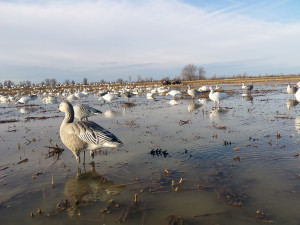 There are many different philosophies in terms of the best way to set decoys when hunting snow geese. You can read one article that will tell you a surefire way and then another that refutes that particular style and gives you another way to organize your spread. The reality is that the area and the age of the of snow geese you are hunting dictates how well the spread will work.
There are many different philosophies in terms of the best way to set decoys when hunting snow geese. You can read one article that will tell you a surefire way and then another that refutes that particular style and gives you another way to organize your spread. The reality is that the area and the age of the of snow geese you are hunting dictates how well the spread will work.
For instance, if you are hunting in cornfields further north rather than rice fields in the southeast, you may need two completely different setups to be effective. You also have to take into account the intelligence and age factor of these birds. They are very observant and very quick to learn, especially where danger is concerned.
Since there is no “one” spread for every occasion solution, you need to become more flexible and willing to try different spreads throughout the season, or even the day. By being more versatile, you will dramatically increase your chances of success (rather than relying on one spread technique that may or may not work during any given session). Furthermore, by creating a variety of spreads, you give the geese a different look they may not be seeing in the area, hence, fooling them into thinking the area is safe to feed.
Going Big or Going Small with Snow Goose Decoy Spreads
Are you ready to pound your head against the wall? If you were hoping we would pick one or the other, you made a very bad assumption. However, what we will tell you is that when you choose big or small, you need to do it right. Smaller, more intimate spreads can be just as effective as a big spread, as long as the spread is done properly.
- When creating a “small” spread, lean more towards full-bodied decoys. There are numerous advantages to these decoys in smaller spreads, most notably they are the most realistic looking. Using windsocks in this type of spread can create some problems, especially in higher winds. Full-bodied decoys, for example, can be set in different directions. Windsock decoys will tend to go in the direction of the wind, creating a uniform and unrealistic looking spread.
- When creating a larger spread, you need to create a huge spread that would mimic the large flocks that you see. A typical spread might be about 300-500 decoys. You can drive from location to location and probably see roughly the same amount of decoys set in the same exact manner. Why not partner up with your friends and combine decoys to create a truly spectacular spread of 1500+ decoys? If you have a four-person group and everyone adds 50 or so decoys each season, you can replace broken decoys and continue to add to the vastness of the spread. It will not be long until you can fill the field or pond with over 1,500 decoys!
This is one of the reasons guided snow goose hunting outfitters have such loyal customers. They are able to create massive spreads over many different locations, all but ensuring the success of every person in the group. Geese sometimes think like people in the sense that they think there is safety in numbers. If they keep coming upon a spread of 200-300 decoys and come under fire, they will eventually avoid those spreads and look for larger or smaller feeding areas. Your big spread will give you the same advantage a professionally guided goose hunting trip offers their clients.
Tips for Setting Your Decoy Spreads
Once you have made your decision to go big or go small, you need to use different techniques that will make the spread look realistic to the birds. Below we have some basic snow goose hunting tips that should help you do just that!
- You should always scout the areas before setting up any spread. You need to know where the birds are going to be in the morning. This can often be accomplished by scouting the fields at dusk. If they are there the night before and fed safely, they will likely return the next day.
- Movement will make your bigger spreads more attractive to geese when flying overhead. If you do not have motion decoys, you can create the appearance of movement with windsocks and flags.
- Try to create “feeding zones” with your spread. By concentrating different “pockets” of decoys throughout the area, it will appear from above as though a group of birds are feeding in one specific area. Spread these clusters throughout your spread area.
- Use a variety of decoys to make it look more natural (i.e., shells, full bodied, silhouettes, floaters, flyers, etc…)
- You can set your blind in two different areas: in the center of your spread or downwind about 100 yards. If you are in the middle of the spread, you will have the challenge of blending in with both the decoys and the terrain. If you are unable to cover yourself properly, consider going downwind and using camo to match the surroundings.












